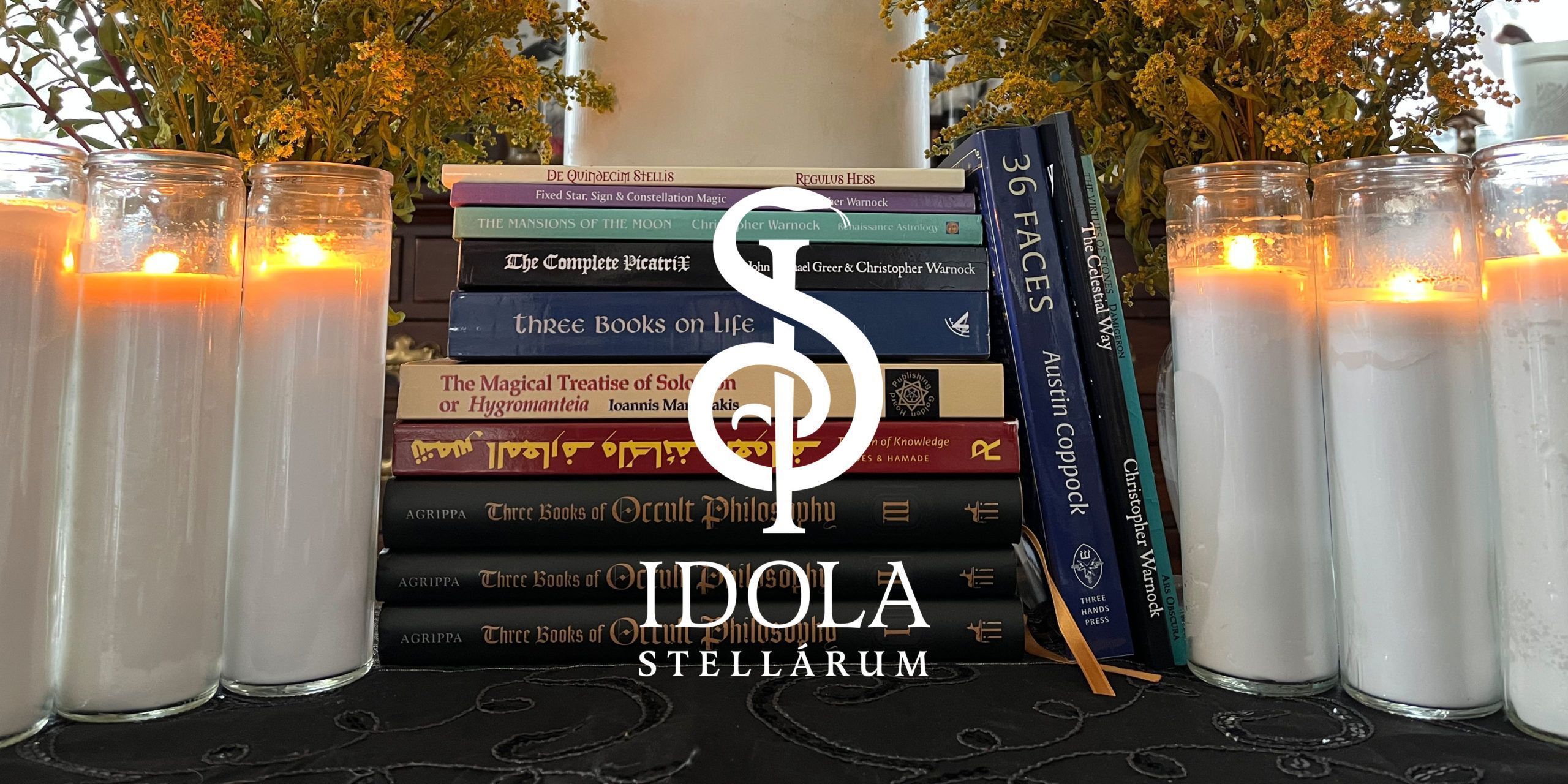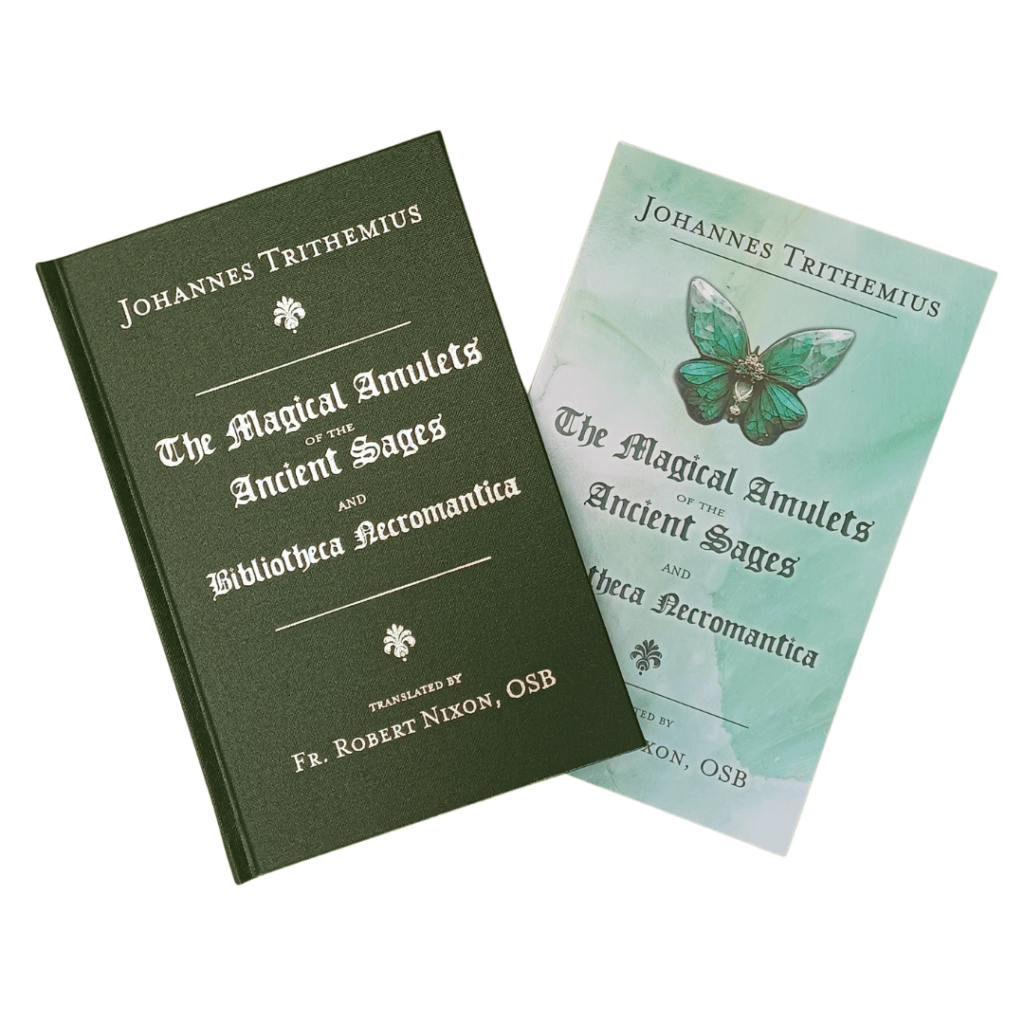Your cart is currently empty!

“The Magical Amulets of the Ancient Sages” (by Trithemius) are Astrological Talismans
We just received our copy of The Magical Amulets of the Ancient Sages (TMAAS), a new translation by Fr. Robert Nixon, OSB of a short book by the German Renaissance polymath and magician Johannes Trithemius, published by Hadean Press.
There was little information about this text when we became aware of it, but the title made us curious whether this work by Trithemius had anything to do with stellar image magic—that is, whether it was a work that intersected with the practice of making astrological talismans. In this post, we provide our initial impressions. Curious? Read on!

(image from the publisher, Hadean Press)
At an initial glance, there is a promising overlap between the contents of TMAAS and the practices of talismanic astrological magic. The five tracts of the book largely contain instructions for carving a particular image onto a particular type of stone with a description of the magical effects of that ‘amulet.’ For example, the very first amulet described in Tract I (“The Amulets of the Archangel Raphael”) is as follows:
“If the image of a beautiful dragon is fashioned out of a ruby, or another rubicund gemstone of a similar nature, you shall find that it has the power of increasing for the person who bears it their prosperity in the goods and riches of this world. It also makes the one who possesses it both happy and healthy.”
—The Magical Amulets of the Ancient Sages, tr. Fr. Robert Nixon, OSB, p. 5
From the perspective of astrological magic, this could be somewhat disappointing: there is no attribution of this image to any particular celestial power, and there are no timing instructions. Since in our tradition, “the virtue of images consists wholly in the election of hours and times of the proper constellations”, and in appropriate substances from which the images are made” (Picatrix, Book I, Chapter 2), this is not encouraging.
However, first impressions can be misleading. Many hints in the text suggest that it is a collection of astrological talismans with most of the astrological information simply missing or redacted.
Overt Astrological Factors
A few overt clues in the text give us a sense that these amulets were originally astrological in nature. Not until Tract II (“The Amulets of Chael the Sage”) do we get any clear astrological factors, but here they take center stage—at least at first. The first amulet described in this tract concludes by saying, “This variety of amulet should be sculpted on the day and hour of Venus.” Likewise, the second amulet notes, “It is especially effective if it is fashioned on the day of Mars.”
This second amulet is especially convincing as an astrological talisman, since the image is a man with a shield, helmet, and sword; furthermore, the instructions say to use red jasper (a stone attributed to Mars by Israel Hibner, Agrippa, and William Lilly) for the purposes of “impart[ing]the ability to defeat any foe in battle” (TMAAS, p. 12).
Puzzlingly, however, the remainder of the amulets described in this tract—and indeed, the rest of the book—omit any further description of astrological timing factors.
However, some other amulets do have overt astrological associations. The final amulet in Tract II instructs the magician to “carve the astronomical (sic) sign of Capricorn into a carnelian” (TMAAS, p. 22) for a variety of effects, including protection, prosperity, friendship, and victory. Similarly, in Tract III, there is an amulet for prosperity that involves “the figure of Aquarius” (TMAAS, p. 27).
In any case, aside from the inclusion of specific astrological factors or images, these amulets do not differ in any significant way from the other recipes in the book. The explicitly astrological amulets are otherwise identical to the other amulets: stone + image (+ astrological factors) adding up to some specific effect or effects for the bearer.
It seems possible that the astrological instructions in the first two amulets are meant as signposts, suggesting that the canny magician should be able to understand the relevant astrological associations and carry out the associated timing instructions for the remainder of the talismans based on their understanding of the images and the stones.
Hints of Fixed Star Lore
Another factor suggesting that these amulets are covert astrological talismans is the existence of various amulets that seem to correspond directly to verifiable astrological talismans from elsewhere in the tradition.
For example, here is an amulet described in Tract I of TMAAS:
“If the likeness of a vulture is fashioned out of chrysolite, it shall confer to its possessor the power of restraining and congregating demonic entities. If it is placed in any location, it shall also defend that location from all evil spirits, and also expel any evil spirits which may already abide there. Such an amulet will render demons obedient to the person who carries it.”
—TMAAS, p. 7
Compare this description of the talisman of Vega from the Quadripertitus version of De Quindecim Stellis:
“The fourteenth stone is Chrysolite… Its virtue is great in affrighting daemons [and] it represseth nocturnal phantoms and fears. … [Its image is] a vulture or a hen.”
—De Quindecim Stellis, tr. Regulus Hess, p. 31 & 40
Similarly, consider the following amulet from Tract V of TMAAS:
“The form of a lion fashioned from granite brings to the one who bears it riches and honors. It makes its possessor joyful, and dispels all traces of melancholy from the heart.”
—TMAAS, p. 42
Compare the talisman of Regulus from Camillo Leonardi’s Speculum Lapidum:
“The form of a lion or cat. If this shall be graven upon garnet, it imparts riches and honors: it cheers the heart and expels sadness.”
—De Quindecim Stellis, tr. Regulus Hess, p. 82
(Note that translators vary on the stone of Regulus. Although the Latin text of TMAAS is not included, the word ‘granatum’ is translated by Eric Purdue as garnet, though some read ‘granite,’ so we consider the divergence in stone in the English translations a matter of little consequence to the underlying correspondence between these two recipes.)
Just slightly later in the same tract, we have the following amulet:
“An amulet of a bull or an ox made from lodestone ensures a safe journey for the one who carries it. It also confers protection against all spells and incantations.”
—TMAAS, p. 43
This is fairly clearly a description of an Alkaid talisman. Compare De Quindecim Stellis, again from Camillo Leonardi’s Speculum Lapidum version:
“The image of a bull or bull-calf. If this be found upon magnet, he who bears it will be able to pass through all places unmolested; it avails, too, against all enchantments and sorcery, and for being taken from one place to another.”
—De Quindecim Stellis, tr. Regulus Hess, p. 82
Clearly, TMAAS is describing a condensed or corrupted form of well-attested astrological talismans. The obvious correspondence between the images, stones, and effects of the TMAAS amulets with talismans from De Quindecim Stellis establish a strong link with well-attested lore in the tradition of fixed star talismans.
Unlike in De Quindecim Stellis, the talismans of TMAAS are not presented in any apparent standard order, and they are bereft of associations with the fixed stars. Although some recipes mention herbs to be placed with the stone, these details are more rare and appear somewhat haphazard.
Somewhat puzzingly, however, one of the tracts contains the amulets of Hermes and mentions De Quindecim Stellis but does not actually contain the 15 Behenian fixed star talismans, let alone in a canonical order.
Similarities with the Liber Sigillorum
Finally, we note that some TMAAS amulets show clear correspondence with talismans described in Liber Sigillorum, though, again, stripped of celestial associations. Take, for example, the following amulet described in Tract 2:
“If the figure of a man holding a lighted candle in his hand is carved out of chrysolite, it has the effect of causing the one who carries it to become wealthy. Such an amulet should be set only in the purest gold.”
—TMAAS, p. 14
Compare this to the following talisman from the Liber Sigillorum, recenly published by Regulus Hess and Christopher Warnock:
“VI. On Chrysolite: under the Sun”
“If thou find this sigil graven upon Chrysolite, that is, a man tall and capable, holding a lighted candle in his hand—this maketh him that bears it wealthy. And it ought to be worn in the purest gold, wherein its virtue is known to be the more effective.”
—De Lapidibus & Liber Sigillorum: Talismanic Lapidaries of Damigeron & Techel, tr. Regulus Hess
Note that Christopher Warnock has recently put up a version of this talisman on his website for sale.
The Magical Amulets of the Ancient Sages Were Probably Astrological Talismans
The handful of overt astrological instructions and images, the clear correspondences with known fixed star talismans, and the parallels with other talismans are strong hints that the book as a whole was either originally derived from texts on astrological magic (i.e., stellar image magic) or was itself intended to be just such a volume itself. Additionally, some of the amulet images on their face seem to be similar if not identical to images described in Picatrix and elsewhere, although a more detailed comparison awaits more careful and judicious investigation.
From the clues in the text, it seems apparent that the magical amulets of the ancient sages described in this new translation of a long-ignored compilation by Trithemius were probably astrological talismans that were stripped of most of their astrological associations.
A final chapter in the Trithemius text makes that claim that the amulets do not work on the basis of their materials or physical qualities, but through divine action and magic. After this claim follows a description of the seven traditional planets with a listing of some of their associations.
Although the author, in a footnote in this section, claims that these planetary descriptions were intended to provide examples of the sorts of magical effects or qualities attributed to the amulets themselves, we suspect that this section served a different purpose.
Trithemius was familiar with the Picatrix: he includes it in his Bibliotheca Necromantica with a dismissive warning a la Albertus Magnus that would keep him on the good side of the church. It seems possible that the final chapter’s description of planetary qualities was a signpost that would suggest to canny magicians that the celestial associations of the listed amulets could be inferred from a deep knowledge of the occult virtues of images and stones.
Very likely, an industrious mage with a working knowledge of Picatrix and other sources could reconstruct a version of The Magical Amulets of the Ancient Sages fit for making astrological talismans, but this would be a project for seasoned astrological magicians. By itself, this text would not be a good place for aspiring astrological magicians to start, since crucial components have mostly been left out or left to inference.
The practical operational value of The Magical Amulets of the Ancient Sages awaits further investigation and experimentation by those already well-versed in the art.
A welcome and curious addition to our library at Idola Stellarum.

